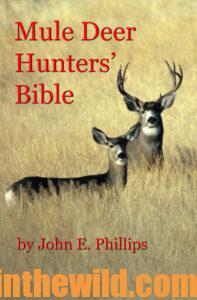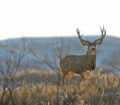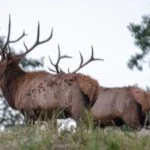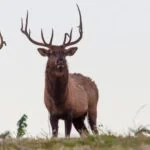Editor’s Note: Longtime, avid hunter Marshall Johnson of Bismarck, North Dakota, is the senior regional director for the Mule Deer Foundation https://muledeer.org/ that restores, improves and protects mule deer habitat, including land and easement acquisitions, and develops programs that help mule deer and black-tailed deer conservation. Mule deer and black-tailed deer live throughout western North America from the coastal islands of Alaska down the West Coast to southern Baja, Mexico, and from the northern border of the Mexican state of Zacatecas, up through the Great Plains to the Canadian provinces of Saskatchewan, Alberta, British Columbia and the southern Yukon Territory. Mule deer: are browsers with a majority of their diet weeds and leaves and twigs of woody shrubs; grow 3 to 3-1/2 feet tall and generally weigh 130-280 pounds; have a 310-degree view around themselves due to their eyes being located on the sides of their heads; can detect movement up to 1900+ feet away; and have a sense of smell 1,000 times stronger than a human’s. Marshall Johnson’s trophies are the lands he’s helped to open up that once were private and today have and are becoming public access for hunters.

The Mule Deer Foundation (MDF) raises money for the conservation of mule deer and their habitat. Like other organizations, we hold fund-raising banquets and events, but 88% of the funds we raise go to a specific mission, which may include seedings for native grasses and shrubs, plantings, working with Game and Fish Departments, reducing conifer production, conducting prescribed burns and doing anything else we can to improve mule deer habitat. The good news is that everything we do for mule deer positively affects all wildlife.
 Up here in North Dakota, our mule deer groups do a lot of dilapidated-fence removal, which benefits the mule deer by our removing barriers that prevent mule deer from having more access to more land. Some of the barbed wire we’re removing has been on the land for 75 years and is bent-down and wound-up. Unfortunately, sometimes mule deer get tangled in that wire. Another part of our effort is pulling out traditional barbed-wire fencing and replacing it with wildlife-friendly fencing. If you’ve been out in the wild very much, every now and then you’ll see a carcass of a wild animal hanging on a barbed-wire fence. However, those sightings don’t include all the wild animals that have caught their legs in fences, wrenched them and broken bones. Perhaps the animals have gotten 100 yards from a fence and then died. We also once found a mule deer that was collared for a study being done that had a big, infected gash on his leg that officials assumed was caused by barbed wire, and that mule deer later died.
Up here in North Dakota, our mule deer groups do a lot of dilapidated-fence removal, which benefits the mule deer by our removing barriers that prevent mule deer from having more access to more land. Some of the barbed wire we’re removing has been on the land for 75 years and is bent-down and wound-up. Unfortunately, sometimes mule deer get tangled in that wire. Another part of our effort is pulling out traditional barbed-wire fencing and replacing it with wildlife-friendly fencing. If you’ve been out in the wild very much, every now and then you’ll see a carcass of a wild animal hanging on a barbed-wire fence. However, those sightings don’t include all the wild animals that have caught their legs in fences, wrenched them and broken bones. Perhaps the animals have gotten 100 yards from a fence and then died. We also once found a mule deer that was collared for a study being done that had a big, infected gash on his leg that officials assumed was caused by barbed wire, and that mule deer later died.
Throughout the mule deer’s range, there’s a lot of abandoned fencing from years of raising livestock. That abandoned fencing is causing serious problems for mule deer, whitetails, antelope and other wildlife. The wildlife-friendly fencing that we suggest is a fence that’s somewhat lower than barbed-wire fencing – about 42-44 inches high. The top wire may be barbed wire or smooth wire, with the second wire being 6-inches lower than to the top wire. So, if a muley or a whitetail’s leg gets caught in the wire, the animal easily can pull its leg out. The bottom wire is a smooth wire, 16-18 inches off the ground for the smaller deer and antelope to go underneath. This arrangement of the wires also helps with muley and whitetail fawns. Many fawns can’t jump a traditional fence and may get hung up in it. But most fawns can go under this new wildlife-friendly fence.

 To learn more about hunting mule deer, go to John E. Phillips’ book, “Mule Deer Hunters’ Bible,” available in Kindle and print versions and including information from 30+ mule deer hunters, at https://www.amazon.com/dp/B07QHCLFYB.
To learn more about hunting mule deer, go to John E. Phillips’ book, “Mule Deer Hunters’ Bible,” available in Kindle and print versions and including information from 30+ mule deer hunters, at https://www.amazon.com/dp/B07QHCLFYB.
















